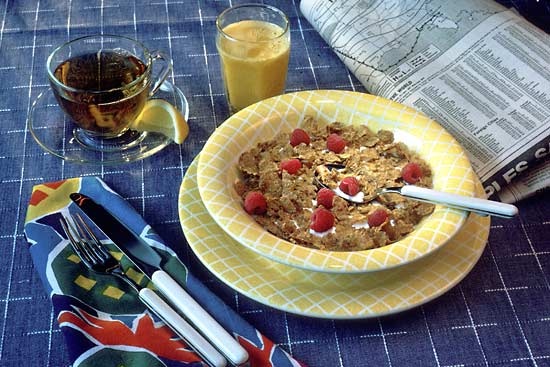breakfast cereal
 grain food, usually pre-cooked or ready-to-eat, that is customarily eaten with milk or cream for breakfast in the United States and elsewhere, often sweetened with sugar, syrup, or fruit. The modern commercial concept of cereal food originated in the vegetarian beliefs of the American Seventh-day Adventists (Seventh-day Adventist), who in the 1860s formed the Western Health Reform Institute, later renamed the Battle Creek Sanitarium, in Battle Creek, Mich. The entrepreneurial possibilities of the ground, thin-baked cereal dough served to the Sanitarium's patients inspired two men, C.W. Post (Post, C W) and W.K. Kellogg (Kellogg, W K), each to found his own business. In the late 20th century the ready-to-eat breakfast cereal industry sold the equivalent of several billion bowls of cereal to Americans yearly, having far surpassed the market for the traditional “hot” cereals made from rolled oatmeal or enriched wheat farina.
grain food, usually pre-cooked or ready-to-eat, that is customarily eaten with milk or cream for breakfast in the United States and elsewhere, often sweetened with sugar, syrup, or fruit. The modern commercial concept of cereal food originated in the vegetarian beliefs of the American Seventh-day Adventists (Seventh-day Adventist), who in the 1860s formed the Western Health Reform Institute, later renamed the Battle Creek Sanitarium, in Battle Creek, Mich. The entrepreneurial possibilities of the ground, thin-baked cereal dough served to the Sanitarium's patients inspired two men, C.W. Post (Post, C W) and W.K. Kellogg (Kellogg, W K), each to found his own business. In the late 20th century the ready-to-eat breakfast cereal industry sold the equivalent of several billion bowls of cereal to Americans yearly, having far surpassed the market for the traditional “hot” cereals made from rolled oatmeal or enriched wheat farina.Ready-to-eat breakfast cereals are of four basic types: flaked, made from corn, wheat, or rice that has been broken down into grits, cooked with flavours and syrups, and then pressed into flakes between cooled rollers; puffed, made by exploding cooked wheat or rice from a pressure chamber, thus expanding the grain to several times its original size; shredded, made from pressure-cooked wheat that is squeezed into strands by heavy rollers, then cut into biscuits and dried; and granular, made by a process in which a stiff dough made from wheat and malted barley flour, salt, yeast, and water is fermented, baked thoroughly, and then, after being crumbled and rebaked, is ground into rough grains. As a final step in each process, the cereal is treated to restore vitamins lost through cooking and often coated with sweet flavouring.
Until the mid- to late 1950s, the market for ready-to-eat breakfast cereal was relatively small, making its subsequent rapid growth one of the most dramatic success stories in modern advertising. By skillful product diversification and promotion, ready-to-eat products took over the breakfast food market—children found a prize in every package or associated a cereal with their favourite cartoon characters, while their parents, ever reminded of the convenience and the nutritional value of fortified cereals, could enter manufacturer-sponsored contests for prizes of their own. Late in the century, the majority of breakfast cereals continued to be directed toward the children's market, with entertainment-oriented packaging and a wide variety of “treat” flavours. Alongside these, the so-called health food movement fostered, or revived, cereals composed of “natural” whole grain and fruit in the old-fashioned granola style.
- Westmorland, Ralph Neville, 1st Earl of, 4th Baron Neville Of Raby
- West, Morris
- West, Nathanael
- West New York
- West Nile virus
- West Nipissing
- Weston
- Weston, Edward
- Weston, Randy
- Weston-super-Mare
- West Orange
- West Oxfordshire
- West Palm Beach
- Westphalia
- Westphalia, Peace of
- West Plains
- West Point
- Westport
- West Scotia Basin
- West Seneca
- West Siberian Plain
- West Somerset
- West Springfield
- West Sussex
- West, The